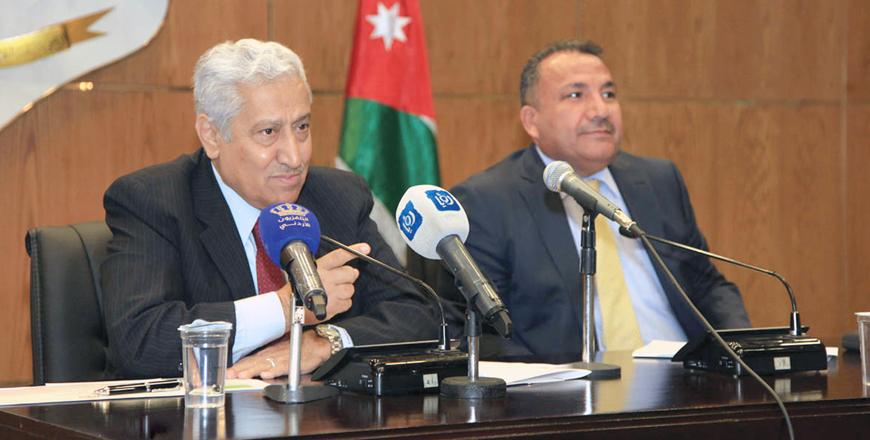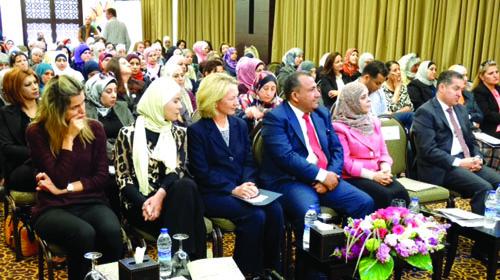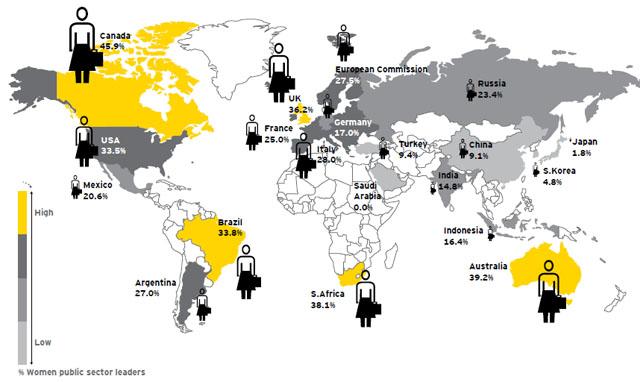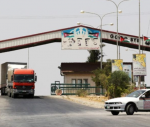You are here
Low ratio of women in senior positions a sign of weakness in development — PM
By Dana Al Emam - Aug 08,2015 - Last updated at Aug 08,2015

Prime Minister Abdullah Ensour speaks at the ninth Government Leaders Forum in Amman on Saturday (Petra photo)
AMMAN — All public agencies must take part in correcting the “imbalance” in the ratio of female employees in senior public sector positions, Prime Minister Abdullah Ensour said Saturday.
In remarks at the ninth Government Leaders Forum, Ensour said it is women’s “constitutional right” to be fairly represented in leading positions, “not a favour or an act of sympathy”.
He also stressed the need to increase the number of female employees in public office at all levels, and to enable them to reach leading positions.
Women constitute 44 per cent of all public sector employees.
At the ministries of health and education, women make up 57 per cent and 53 per cent of employees respectively, according to a study on women in the public sector, conducted by the Ministry of Public Sector Development.
However, women constitute around 24 per cent of employees in all other public agencies, which the premier referred to as an indication of a “tremendous weakness in development”.
He added that it is an economic and social loss that must be addressed to benefit from the skills and expertise of women in public office.
“It is not a governmental need, but a societal one,” Ensour said, adding that change will come; therefore, it should be organised and systemised, not arbitrary.
The study is the first of three components of the ministry’s project to empower women in the public sector, a pillar of its executive plan for 2015, according to Minister of Public Sector Development Khleef Al Khawaldeh.
The following phases seek to engage female employees in capacity-building training and also include reviewing legal frameworks to bridge any gaps in legislation, if found.
The study, which covered all 103 public agencies across the Kingdom over the first quarter of this year, examined the positions of female public sector employees based on professional ranking, career level, educational background and geographical distribution.
The ratio of women in the public sector’s highest category is the lowest at 7 per cent, while the highest ratio of female employees was in the second category (around 55 per cent).
Around 30 per cent of employees hired through contracts for jobs or projects that require specialised expertise are women.
The study said females make up around 29 per cent of employees in senior and supervisory positions.
Concerning academic background, female PhD holders form 18 per cent of an overall number of 1,878 PhD holders in the public sector, while women with a master’s degree make up 40 per cent of all staff.
Although development rates in the central region are higher than those in the northern and southern regions, the overall percentage of female employees in public agencies in the north stood at 47 per cent, while in the south it was 44 per cent, and 43 per cent in the central region.
Karak Governorate had the highest ratio of female workers, at around 51 per cent, while Aqaba Governorate had the lowest (32 per cent).
Khawaldeh said the Cabinet has directed public agencies to consider the study when taking the needed measures to increase women’s opportunities in reaching leading positions, based on merit.
“This is not a call for a quota for women, but a need to provide equal opportunities to male and female employees,” he said.
The Higher Council for the Affairs of Persons with Disabilities has the highest ratio of female employees, reaching around 60 per cent, while the Iftaa Department and Chief Islamic Justice Department have no female personnel.
The ministry’s USAID-funded project, which is carried out in cooperation with the Jordanian National Commission for Women, aims to engage 180 female public sector employees in a capacity-building programme to enhance their leadership skills and enable them to reach higher administrative positions.
A total of 60 female employees have finished a five-week training, while 30 men are currently receiving training, with a plan to train the remaining 90 before the end of this year, according to the ministry.
Related Articles
A total of 120 female public sector employees are scheduled to participate in a capacity-building programme that seeks to enhance women’s leadership skills and to enable them to reach higher administrative positions.
AMMAN — The Ministry of Public Sector Development will conduct a study towards the end of this year to evaluate the impact of its programmes
Women constituted 45 per cent of the public sector workforce in the first quarter of 2015, but their representation in the senior-most positions stood at 7 per cent, according to an official study.
















